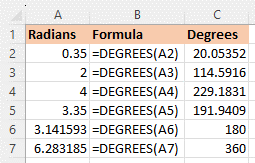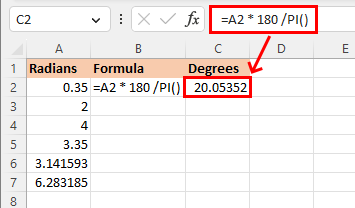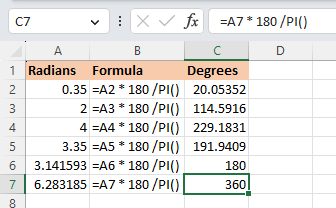Radians and degrees are units of angle. One turn around a circle (360°) is equal to 2π radians.
In this tutorial, we will learn how to convert radians to degrees in Excel using a function and a formula.
Convert Using the DEGREES Function
The DEGREES function takes an angle (in radians) and converts it into degrees. The syntax of the DEGREES function is as follows:
=DEGREES(angle_radians)
Let’s see examples of how the function works. In a blank cell write the following formula:
=DEGREES(0.35)

The result is 20.05352. This means that 0.35 radians are equal to around 20 degrees.
You can also use a cell name inside the DEGREES function.
=DEGREES(A2)
Below are more examples of the function:

Convert Using the PI Formula
Instead of using the DEGREES function, you can directly use the formula for converting radians into degrees. The formula goes like this:
= angle_radians * 180 / PI()
Let me explain the formula. To convert radians to degrees, you need to multiply the angle in radians by 180 and divide it by pi, which is a mathematical constant (π = 3.14159265359…). The pi number can be used in Excel through the PI() function.
Let’s apply this formula to a single angle:
=0.35 * 180 /PI()

When we convert 0.35 into degrees, the result is 20.05352, which is consistent with the output we got when we used the DEGREES function.
You can also apply this formula to multiple cells. Firstly, write the formula for an initial cell:

Then, click on the small rectangle in the lower right corner of the cell, and drag it downward.

This way, the formula will be applied to multiple cells with the help of auto-fill:

And now, we learned how to convert radians to degrees using the DEGREES function and a mathematical formula. Nicely done!
Feel free to check on these articles as well to learn more about how to convert other kinds of numbers in Excel.
